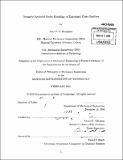Dynamic reduced order modeling of entrained flow gasifiers
Author(s)
Monaghan, Rory F. D. (Rory Francis Desmond)
DownloadFull printable version (40.29Mb)
Other Contributors
Massachusetts Institute of Technology. Dept. of Mechanical Engineering.
Advisor
Ahmed F. Ghoniem.
Terms of use
Metadata
Show full item recordAbstract
Gasification-based energy systems coupled with carbon dioxide capture and storage technologies have the potential to reduce greenhouse gas emissions from continued use of abundant and secure fossil fuels. Dynamic reduced order models (ROMs) that predict the operation of entrained flow gasifiers (EFGs) within IGCC (integrated gasification combined cycle) or polygeneration plants are essential for understanding the fundamental processes of importance. Such knowledge can be used to improve gasifier reliability, availability and maintainability, leading to greater commercialization of gasification technology. A dynamic ROM, implemented in Aspen Custom Modeler, has been developed for a range of EFGs. The ROM incorporates multiple feedstocks, mixing and recirculation, particle properties, drying and devolatilization, chemical kinetics, fluid dynamics, heat transfer, pollutant formation, slag behavior and syngas cooling. The ROM employs a reactor network model (RNM) that approximates complex fluid mixing and recirculation using a series of idealized chemical reactors. The ROM was successfully validated for steady-state simulation of four experimental gasifiers. The throughputs of these gasifiers range from 0.1 to 1000 metric tonnes per day (3 kWth - 240 MWth). Sensitivity analysis was performed to identify the parameters most important to ROM accuracy. The most important parameters are found to be those that determine RNM geometry, particle physical and kinetic properties, and slagging. The ROM was used to simulate the steady-state and dynamic performance of a full-scale EFG system. In steady-state mode, the ROM was used to establish base case and fluxant requirements. The base case performance agreed with design specifications. Steady-state simulation was also used to determine important states for dynamic simulation. Six cases were examined in dynamic mode, including gasifier cold start. Dynamic results showed agreement with industrial experience for gasifier start-up times.
Description
Thesis (Ph. D.)--Massachusetts Institute of Technology, Dept. of Mechanical Engineering, 2010. Cataloged from PDF version of thesis. Includes bibliographical references.
Date issued
2010Department
Massachusetts Institute of Technology. Department of Mechanical EngineeringPublisher
Massachusetts Institute of Technology
Keywords
Mechanical Engineering.